Composable Infrastructure Market Size
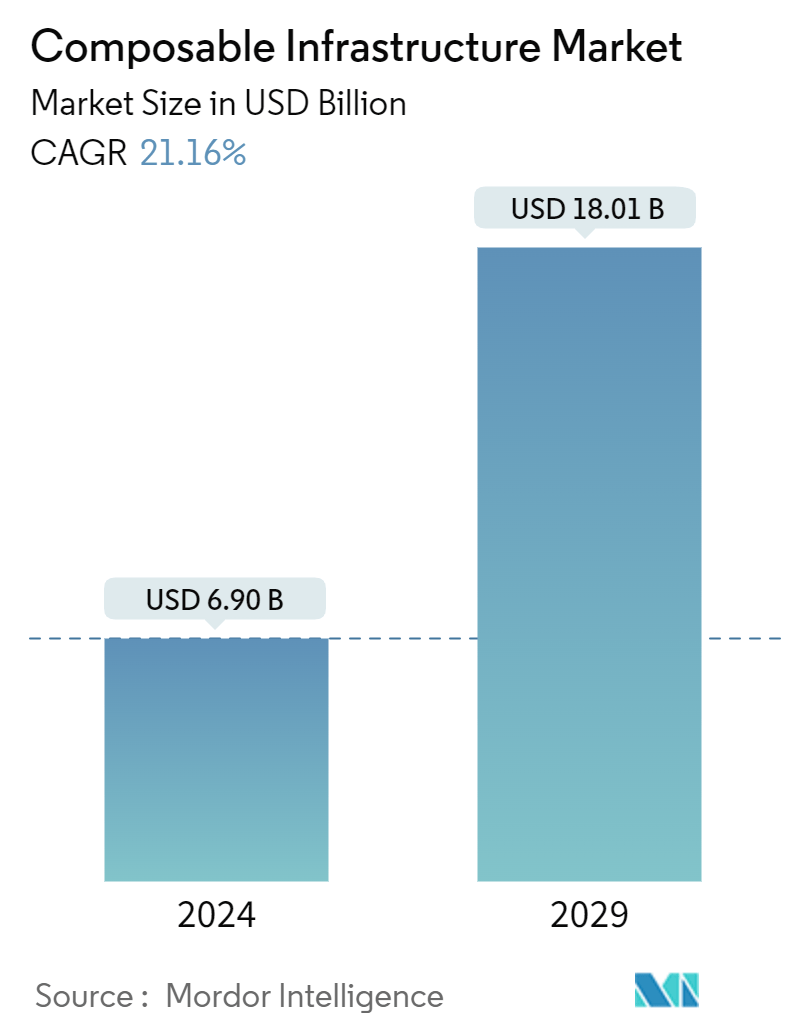
| Study Period | 2019 - 2029 |
| Market Size (2024) | USD 6.90 Billion |
| Market Size (2029) | USD 18.01 Billion |
| CAGR (2024 - 2029) | 21.16 % |
| Fastest Growing Market | Asia Pacific |
| Largest Market | North America |
Major Players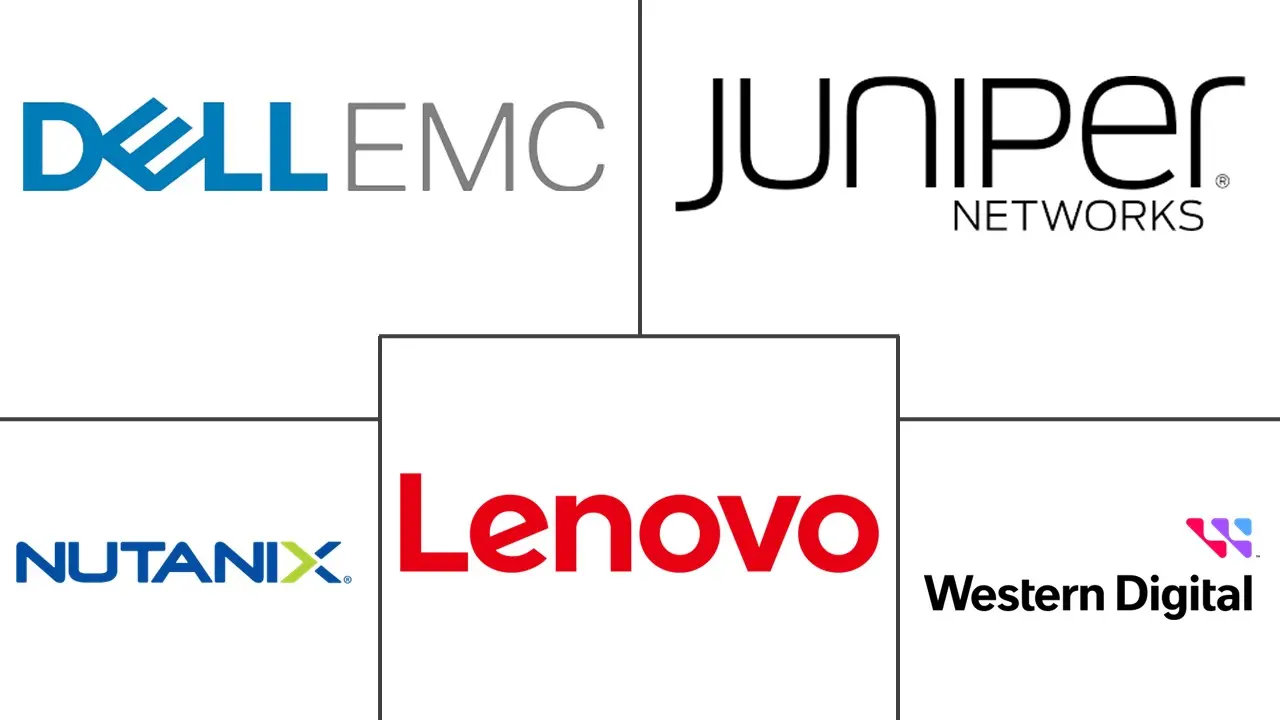
*Disclaimer: Major Players sorted in no particular order |
Composable Infrastructure Market Analysis
The Composable Infrastructure Market size is estimated at USD 6.90 billion in 2024, and is expected to reach USD 18.01 billion by 2029, growing at a CAGR of 21.16% during the forecast period (2024-2029).
- Composable infrastructure is the IT infrastructure created by separating distinct components of the data center architecture, such as computation, networking, and storage, and combining them in numerous ways to meet the needs of specific workloads. Increased customer expectations, expanding business analytics workload, deployment of DevOps approaches, the development of automation and standardization technologies, and the increasing acceptance of hybrid cloud are all expected to boost the growth of the composable infrastructure market.
- Businesses increasingly adopt composable infrastructure solutions to reduce capital expenditures and enhance infrastructure utilization. Composable infrastructure enables the dynamic assembly and disassembly of resources based on application demands. This allows for the optimized allocation of pooled resources, improving overall infrastructure efficiency.
- Additionally, composable infrastructure supports flexibility and agility by facilitating rapid provisioning, re-provisioning, and upgrading infrastructure. The ability to integrate existing hardware with software-defined infrastructure is also driving adoption. The rapid growth in data volumes and infrastructure virtualization across industries is expected to impact the market positively.
- The shortage of skilled workers prevents the start of some composable infrastructure projects. However, even if they are tackled, the need for experienced professionals often extends the project duration. Since the European labor market does not produce appropriately qualified workers, innovations are expected to fail even if the company has sufficient financial resources.
- In the current scenario, the macroeconomic situation remains volatile, and players continue to see macro trends such as high interest rates, inflation, fear of recession, and geopolitical tensions increasing in some parts of the world, which can impact the industrial activities in the future, and can impact the demand for the market. In April 2024, UN Trade and Development (UNCTAD) forecasted global economic growth to slow at 2.6%, marginally above the 2.5% threshold commonly associated with a recession, which would lower the market growth.
Composable Infrastructure Market Trends
IT and Telecom Industry to be the Largest End User
- IT and telecom enterprises are willing to accelerate their apps, data, and innovation in the current scenario. They need to manage conventional bare-metal and virtualization applications more efficiently while supporting the containerized applications with software-driven automation and a fluid pool of resources that may flexibly custom fit the specific requirements.
- The telecommunications industry now regards CI/CD (Continuous Integration/Continuous Deployment, generally referred to as Composable Infrastructure) as a critical step in a service provider's fifth-generation (5G) core deployment journey. The essence of composable functional capabilities lies in creating modular and interoperable solutions that adapt to the evolving needs of businesses in the 5G ecosystem. Recently, Liqid showcased VMware's hyperconverged infrastructure (HCI) software running on top of Liqid's disaggregated composable infrastructure for 5G.
- 5G URLLC (Ultra-Reliable and Low-Latency Communications) started with 3GPP Release 15, which met the requirements for implementing long-range PCIe and enabled the design of composable edge cloud storage over 5G. They use COTS hardware comprising AMD/Xilinx Ultrascale+MPSoC and 5G modems to connect a standard NVMe SSD with a standard CPU running Linux and the NVMe protocol. Overall, it is possible to tunnel PCIe over 5G, although it is not entirely reliable due to the TCP tail latency. While the latency and bandwidth pose a significant bottleneck, improvements with the upcoming releases of 5G, such as URLLC, should alleviate these issues.
- The telco industry has been built on top of back-office systems like revenue assurance and billing and customer data programs. A fragmented commerce landscape is usually commonplace, including a POS platform for brick-and-mortar stores and a stand-alone e-commerce solution. Also, many telcos rely on separate customer service platforms to support customer inquiries that reach their contact centers. Usually, this assortment of solutions fails to sync and share information, leading to data silos and disjointed customer journeys.
- According to Ericsson, by 2028, 5G is anticipated to become the leading mobile access technology by subscription. Projections indicate that global 5G subscriptions will nearly reach 5.6 billion by 2029, accounting for 60% of all mobile subscriptions. The telecommunications sector now considers CI/CD essential in the deployment journey of a service provider's fifth-generation (5G) core. Transitioning to cloud-native 5GC introduces new operational and management challenges for CSPs, necessitating intentional operational transformation.
- These challenges include more frequent updates to test infrastructure and test cases, incremental delivery and deployment that also require incremental security measures, a cultural shift toward the DevSecOps model to integrate security into the rapid-release cycles typical of modern CI/CD processes, and the implementation of cloud-native technology, microservices, and service-based architectures, which drive increasingly higher levels of automation.
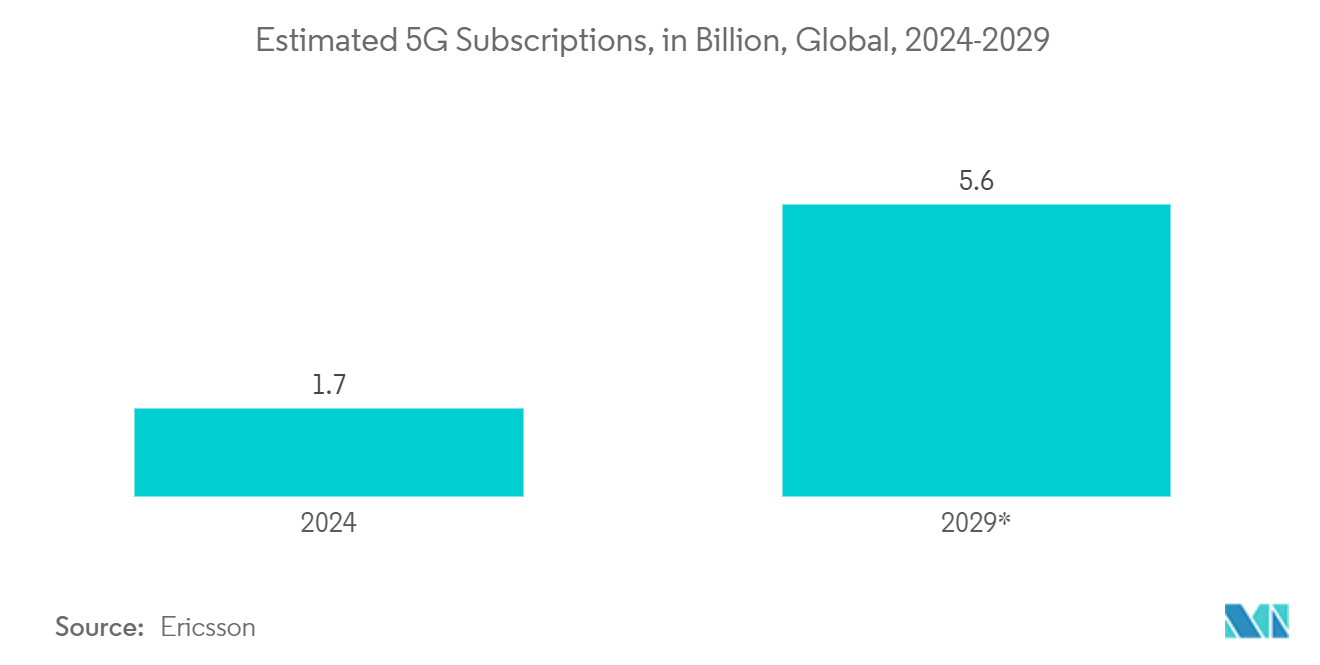
North America Holds Largest Market Share
- The North American region dominates the composable infrastructure market, with the United States occupying a significant market share. The major reason for the region's dominance is the presence of leading composable infrastructure solution providers, such as Cisco, Juniper Networks, Liqid Inc., Nutanix Inc., and Hewlett Packard Enterprise. These players focus on partnerships, mergers and acquisitions, and innovative solutions to stay in the regional and global competitive landscapes.
- The North American region plays a crucial role in enhancing the growth of the software-defined network service market. This is mainly because of factors like the implementation and acceptance of advanced technology, developments in network automation, and the surge in the number of cloud-based services. Over the next five years, most IT teams will increasingly adopt NaaS (Network-as-a-service) as suppliers deliver hybrid offerings that include software, cloud intelligence, and the option for managing on-premises hardware.
- The market is witnessing potential product innovations and capital investments, which suggest the increasing acceptance and demand for such solutions, especially in the field of supercomputers, HPCs, and AI and ML computations.
- For instance, in October 2023, Cerio announced an advanced development in composable infrastructure, advancing PCIe systems beyond a single domain and introducing new "scale economics" for AI and cloud data centers. The innovative Cerio platform enables data centers to manage their infrastructure programmatically, providing unprecedented operational flexibility to handle system capacity, upgrades, and repairs. Leveraging its extensive experience in distributed architectures and multipath fabrics, Cerio has designed highly robust and heterogeneous systems. Cerio is collaborating with early-access customers in North America, Europe, and Asia-Pacific to implement critical use cases, including scalable GPU capacity and storage agility.
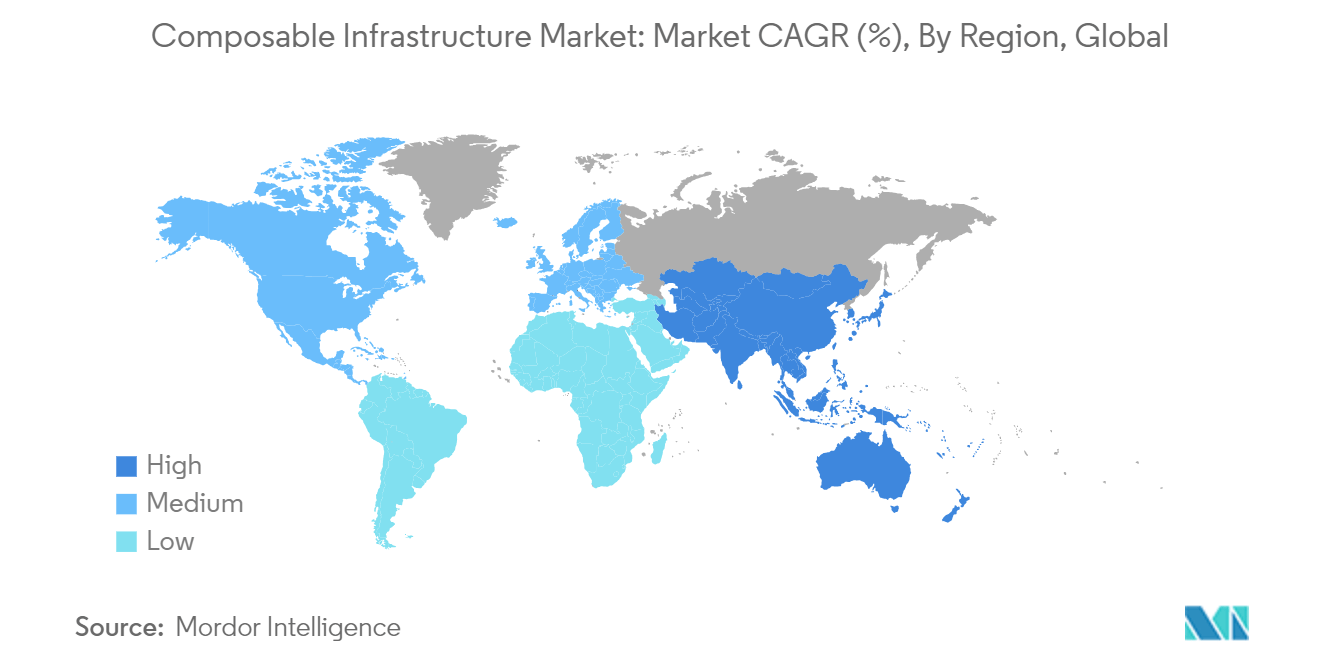
Composable Infrastructure Industry Overview
The Composable Infrastructure Market is highly fragmented due to the presence of both global players and small and medium-sized enterprises. Some of the major players in the market are Nutanix Inc., Juniper Networks Inc., Lenovo Group Limited, Dell EMC (Dell Technologies Inc.), and Western Digital Corp. Players in the market are adopting strategies such as partnerships and acquisitions to enhance their product offerings and gain sustainable competitive advantage.
- March 2024 - Wipro Limited, a significant player in technology services and consulting, and Nutanix, Inc., announced a dedicated business unit centered on Nutanix solutions. This collaboration aims to expedite clients' digital and hybrid multi-cloud transitions and optimize their Nutanix Cloud returns. By merging Wipro's FullStride Cloud's domain knowledge with Nutanix's platform, the new unit is set to bolster joint solution development and broaden market penetration.
- March 2024 - Lenovo Group Limited has inked a Strategic Collaboration Framework Agreement and a Bond Subscription Agreement with Alat, a Public Investment Fund concentrating on tech investments and sustainable manufacturing. This collaboration and investment are poised to propel Lenovo's transformation, bolster its global standing, diversify its manufacturing locations, and leverage the MEA region's burgeoning IT and Business Services sector.
Composable Infrastructure Market Leaders
-
Nutanix Inc.
-
Juniper Networks Inc.
-
Lenovo Group Limited
-
Dell EMC (Dell Technologies Inc.)
-
Western Digital Corp.
*Disclaimer: Major Players sorted in no particular order
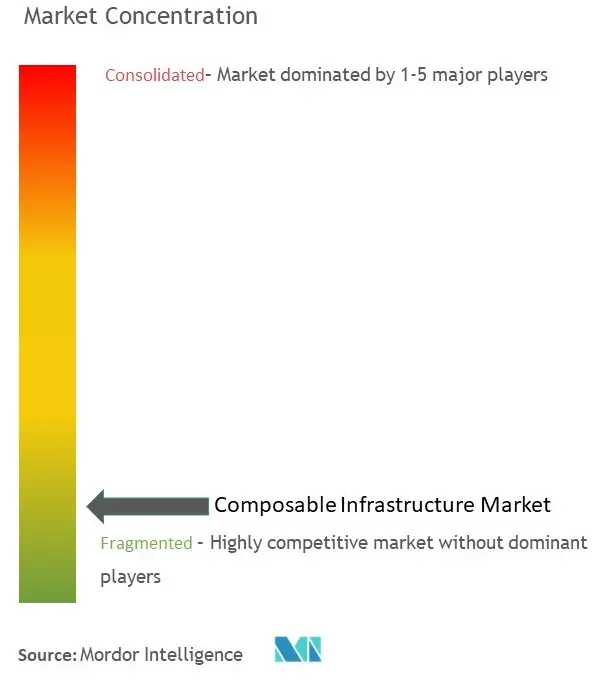
Composable Infrastructure Market News
- May 2024 - May 2024, Dell and Databricks announced a Multicloud Analytics and AI Solution. This partnership will bring customers cloud-based analytics and AI using Databricks with data stored in Dell Object Storage.
- March 2024 - Lenovo and Cisco have announced a strategic partnership to provide comprehensive infrastructure and networking solutions. This collaboration is tailored to expedite digital transformations for businesses, regardless of scale. The firms have formalized their commitment through a memorandum of understanding (MoU). This agreement outlines their collaborative efforts to develop and implement plans that facilitate digital transformations. They focus on offering turnkey solutions that seamlessly integrate standard networking and AI infrastructure, catering to clients globally, from the edge to the cloud.
Composable Infrastructure Market Report - Table of Contents
1. INTRODUCTION
- 1.1 Study Assumptions and Market Definition
- 1.2 Scope of the Study
2. RESEARCH METHODOLOGY
3. EXECUTIVE SUMMARY
4. MARKET INSIGHTS
- 4.1 Market Overview
-
4.2 Industry Attractiveness - Porter's Five Forces Analysis
- 4.2.1 Bargaining Power of Suppliers
- 4.2.2 Bargaining Power of Consumers
- 4.2.3 Threat of New Entrants
- 4.2.4 Threat of Substitutes
- 4.2.5 Competitive Rivalry Within the Industry
- 4.3 Industry Value Chain Analysis
- 4.4 Assessment of the Impact of Macro Economic Factors on the Market
5. MARKET DYNAMICS
-
5.1 Market Drivers
- 5.1.1 Significantly High Scalability of Composable Infrastructure
-
5.2 Market Challenges
- 5.2.1 Lack of Awareness and Skill Set to Implement a Composable Infrastructure
6. MARKET SEGMENTATION
-
6.1 By Type
- 6.1.1 Software
- 6.1.2 Hardware
-
6.2 By End User Verticals
- 6.2.1 IT and Telecom
- 6.2.2 BFSI
- 6.2.3 Healthcare
- 6.2.4 Industrial Manufacturing
- 6.2.5 Other End-user Verticals
-
6.3 By Geography***
- 6.3.1 North America
- 6.3.2 Europe
- 6.3.3 Asia
- 6.3.4 Australia and New Zealand
- 6.3.5 Latin America
- 6.3.6 Middle East and Africa
7. COMPETITIVE LANDSCAPE
-
7.1 Company Profiles*
- 7.1.1 Nutanix Inc.
- 7.1.2 Juniper Networks Inc.
- 7.1.3 Lenovo Group Limited
- 7.1.4 Dell EMC (Dell Technologies Inc.)
- 7.1.5 Western Digital Corp.
- 7.1.6 Hewlett Packard Enterprise Co.
- 7.1.7 NetApp Inc.
- 7.1.8 Cisco Systems Inc.
- 7.1.9 Gigaio Networks inc.
- 7.1.10 One Stop Systems Inc.
- 7.1.11 Liqid Inc.
8. INVESTMENT ANALYSIS
9. FUTURE OF THE MARKET
** Subject To AvailablityComposable Infrastructure Industry Segmentation
Composable infrastructure offers value to continue business operations and development by providing increased efficiencies in the system infrastructure operations. The analysis is based on the market insights captured through secondary research and the primaries. The market also covers the major factors impacting the growth of the market in terms of drivers and restraints. The study’s scope tracks the adoption of composable infrastructure solutions used by various end-user verticals in multiple geographies, including their shares, based on inputs received from the industry stakeholders covering both software and hardware.
The composable infrastructure market is segmented by type (software, hardware), by end-user verticals (IT and telecom, BFSI, healthcare, industrial manufacturing, and other end-user verticals), and by geography (North America, Europe, Asia Pacific, Rest of the World). The report offers market forecasts and size in value (USD) for all the above segments.
| By Type | Software |
| Hardware | |
| By End User Verticals | IT and Telecom |
| BFSI | |
| Healthcare | |
| Industrial Manufacturing | |
| Other End-user Verticals | |
| By Geography*** | North America |
| Europe | |
| Asia | |
| Australia and New Zealand | |
| Latin America | |
| Middle East and Africa |
Composable Infrastructure Market Research FAQs
How big is the Composable Infrastructure Market?
The Composable Infrastructure Market size is expected to reach USD 6.90 billion in 2024 and grow at a CAGR of 21.16% to reach USD 18.01 billion by 2029.
What is the current Composable Infrastructure Market size?
In 2024, the Composable Infrastructure Market size is expected to reach USD 6.90 billion.
Who are the key players in Composable Infrastructure Market?
Nutanix Inc., Juniper Networks Inc., Lenovo Group Limited, Dell EMC (Dell Technologies Inc.) and Western Digital Corp. are the major companies operating in the Composable Infrastructure Market.
Which is the fastest growing region in Composable Infrastructure Market?
Asia Pacific is estimated to grow at the highest CAGR over the forecast period (2024-2029).
Which region has the biggest share in Composable Infrastructure Market?
In 2024, the North America accounts for the largest market share in Composable Infrastructure Market.
What years does this Composable Infrastructure Market cover, and what was the market size in 2023?
In 2023, the Composable Infrastructure Market size was estimated at USD 5.44 billion. The report covers the Composable Infrastructure Market historical market size for years: 2019, 2020, 2021, 2022 and 2023. The report also forecasts the Composable Infrastructure Market size for years: 2024, 2025, 2026, 2027, 2028 and 2029.
Composable Infrastructure Industry Report
Statistics for the 2024 Composable Infrastructure market share, size and revenue growth rate, created by Mordor Intelligence™ Industry Reports. Composable Infrastructure analysis includes a market forecast outlook to 2029 and historical overview. Get a sample of this industry analysis as a free report PDF download.



